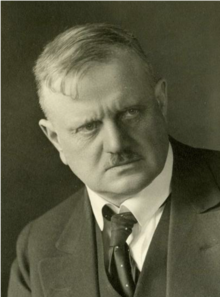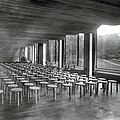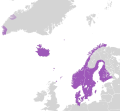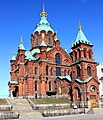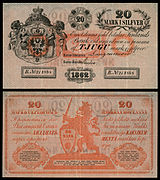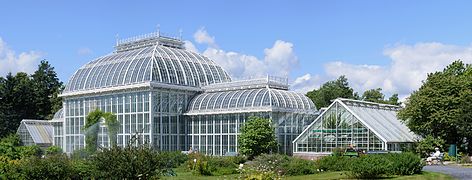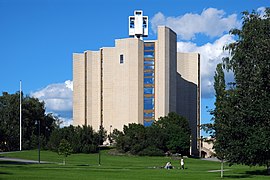The Finland Portal


Finland, officially the Republic of Finland, is a Nordic country in Northern Europe. It borders Sweden to the northwest, Norway to the north, and Russia to the east, with the Gulf of Bothnia to the west and the Gulf of Finland to the south, opposite Estonia. Finland covers an area of 338,145 square kilometres (130,559 sq mi) and has a population of 5.6 million. Helsinki is the capital and largest city. The vast majority of the population are ethnic Finns. Finnish and Swedish are the official languages, with Swedish being the native language of 5.2% of the population. Finland's climate varies from humid continental in the south to boreal in the north. The land cover is predominantly boreal forest biome, with more than 180,000 recorded lakes.
Finland was first settled around 9000 BC after the last Ice Age. During the Stone Age, various cultures emerged, distinguished by different styles of ceramics. The Bronze Age and Iron Ages were marked by contacts with other cultures in Fennoscandia and the Baltic region. From the late 13th century, Finland became part of the Swedish Empire as a result of the Northern Crusades. In 1809, as a result of the Finnish War, Finland was captured from Sweden and became a Grand Duchy of Finland, an autonomous state ruled by the Russian Empire. During this period, Finnish art flourished and the idea of full independence began to take hold. In 1906, Finland became the first European state to grant universal suffrage, and the first in the world to give all adult citizens the right to run for public office. Following the Russian Revolution of 1917, Finland declared its full independence. In 1918 the young nation was divided by the Finnish Civil War. During World War II, Finland fought against the Soviet Union in the Winter War and the Continuation War, and later against Nazi Germany in the Lapland War. As a result, it lost parts of its territory but retained its independence. ( Full article...)
Selected article -
The Oceanides (in Finnish: Aallottaret; literal English translation: Nymphs of the Waves or Spirits of the Waves; original working title: Rondeau der Wellen; in English: Rondo of the Waves), Op. 73, is a single- movement tone poem for orchestra written from 1913 to 1914 by the Finnish composer Jean Sibelius. The piece, which refers to the nymphs in Greek mythology who inhabited the Mediterranean Sea, premiered on 4 June 1914 at the Norfolk Music Festival in Connecticut with Sibelius conducting. Praised upon its premiere as "the finest evocation of the sea ... ever ... produced in music", the tone poem, in D major, consists of two subjects, said to represent the playful activity of the nymphs and the majesty of the ocean, respectively. Sibelius gradually develops this material over three informal stages: first, a placid ocean; second, a gathering storm; and third, a thunderous wave-crash climax. As the tempest subsides, a final chord sounds, symbolizing the mighty power and limitless expanse of the sea.
Stylistically, many commentators have described The Oceanides as an example of Impressionism. Others have countered that Sibelius's active development of the two subjects, his sparing use of scales favored by Impressionists, and his prioritization of action and structure over ephemeral, atmospheric background distinguish the piece from quintessential examples, such as Debussy's La mer. ( Full article...)Selected image -
Did you know (auto-generated)

- ... that Pirjo Ala-Kapee-Hakulinen was the first and only governor of the Eastern Finland Province from its creation in 1997 to its abolition in 2010?
- ... that Vieno Simonen was first elected to the Finnish parliament in 1948, ten years after she was widowed with seven children?
- ... that the United States severed diplomatic ties with Finland in 1944 because of a personal letter sent to Hitler?
- ... that a song about an esports team went viral in Finland?
- ... that Alli Lahtinen, the first woman to lead a central government agency in Finland, helped establish the country's national child care system?
- ... that Kaija Saariaho's 2021 opera Innocence includes traditional Finnish cow-herding calls?
WikiProjects

You are invited to participate in Finland WikiProject, a WikiProject dedicated to developing and improving articles about Finland.
More did you know -
- ...that the prototypes for the WW II German U-boat fleet ( Type II pictured) were designed by a Dutch company and built in Finland at the Crichton-Vulcan shipyard?
- ...that while repelling Soviet advances across the frozen Lake Suvanto, Finland managed to capture 12 anti-tank guns, 140 machine guns, 200 light machine guns and 1500 rifles in the Battle of Kelja in 1939?
- ...that Major Carl Mothander, the leader of Swedish volunteers in the Estonian War of Independence, later wrote books on Estonian politics that were banned in Finland?
- ...that the Korpela movement was a short-lived cult during the 1930s in Northern Sweden and Finland whose controversial sexual rituals eventually led to the arrest of 60 followers?
- ...that in 1745, Daniel Juslenius, a Finnish Fennoman, finished the first formal Finnish dictionary?
The Continuation War, also known as the Second Soviet-Finnish War, was a conflict fought by Finland and Nazi Germany against the Soviet Union during World War II. It began with a Finnish declaration of war and invasion on 25 June 1941 and ended on 19 September 1944 with the Moscow Armistice. The Soviet Union and Finland had previously fought the Winter War from 1939 to 1940, which ended with the Soviet failure to conquer Finland and the Moscow Peace Treaty. Numerous reasons have been proposed for the Finnish decision to invade, with regaining territory lost during the Winter War regarded as the most common. Other justifications for the conflict include Finnish President Risto Ryti's vision of a Greater Finland and Commander-in-Chief Carl Gustaf Emil Mannerheim's desire to annex East Karelia.
General images
In the news
- 2 April 2024 – Viertola school shooting
- A student is killed and two others are injured in a shooting at a school in Vantaa, Uusimaa, Finland. A 12-year-old student is detained. (AP) (Yle)
- 1 March 2024 – 2024 Finnish presidential election
- Alexander Stubb is sworn in as the 13th President of Finland. (Reuters)
- 11 February 2024 – 2024 Finnish presidential election
- Alexander Stubb is elected President of Finland with 51.6% of the vote. (Yle)
- 27 January 2024 – Israel–Hamas war
- The United Kingdom, United States, Australia, Italy, Canada, Finland, the Netherlands, Switzerland, and Germany suspend humanitarian aid to UNRWA over allegations that some UNRWA staff members were involved in the Hamas-led attack on Israel. (BBC News) (CBS News)
- 14 December 2023 – Finland–United States relations
- Finland announces the creation of a defense cooperation agreement with the United States. The agreement will grant Finland access to American military resources for use in defensive operations, while the US will gain military access to Finland in the event of conflict. (Reuters)
- 29 November 2023 – Finland–Poland relations, Finland–Russia relations
- National Security Bureau chief Jacek Siewiera announces that Poland will send "a team of military advisors" to the Finland–Russia border in response to an official request for allied support. Finland says it was unaware of the Polish offer. Russia warns against the move, viewing the concentration of troops on the border as a threat. (Reuters)
Related portals
Northern Europe
Other countries
Selected panorama -
Topics
Categories
Recognized content
Things you can do
- Add the {{Portal|Finland}} template to existing See also sections of Finland-related articles.
- Tag the talk pages of Finland-related articles with the {{ WikiProject Finland}} template. (Tip: Use PetScan to find articles not tagged yet by replacing the category "Finnish films" with another category and adjust "Depth" if needed. This tool is helpful for tagging. See also the list of pages not tagged yet.)
- Rate unassessed and unknown-importance articles according to the guidelines. ( This tool is helpful for doing these.)
- Translate a Finnish-language article into English.
- Expand a stub into a full article.
- Help with the articles needing attention ( watch) and cleanup.
- Create a requested article ( watch).
- Support fresh articles ( watch).
- Patrol the recent changes.
- Add the following pages to your watchlist:
Associated Wikimedia
The following Wikimedia Foundation sister projects provide more on this subject:
-
Commons
Free media repository -
Wikibooks
Free textbooks and manuals -
Wikidata
Free knowledge base -
Wikinews
Free-content news -
Wikiquote
Collection of quotations -
Wikisource
Free-content library -
Wikiversity
Free learning tools -
Wikivoyage
Free travel guide -
Wiktionary
Dictionary and thesaurus
The Finland Portal


Finland, officially the Republic of Finland, is a Nordic country in Northern Europe. It borders Sweden to the northwest, Norway to the north, and Russia to the east, with the Gulf of Bothnia to the west and the Gulf of Finland to the south, opposite Estonia. Finland covers an area of 338,145 square kilometres (130,559 sq mi) and has a population of 5.6 million. Helsinki is the capital and largest city. The vast majority of the population are ethnic Finns. Finnish and Swedish are the official languages, with Swedish being the native language of 5.2% of the population. Finland's climate varies from humid continental in the south to boreal in the north. The land cover is predominantly boreal forest biome, with more than 180,000 recorded lakes.
Finland was first settled around 9000 BC after the last Ice Age. During the Stone Age, various cultures emerged, distinguished by different styles of ceramics. The Bronze Age and Iron Ages were marked by contacts with other cultures in Fennoscandia and the Baltic region. From the late 13th century, Finland became part of the Swedish Empire as a result of the Northern Crusades. In 1809, as a result of the Finnish War, Finland was captured from Sweden and became a Grand Duchy of Finland, an autonomous state ruled by the Russian Empire. During this period, Finnish art flourished and the idea of full independence began to take hold. In 1906, Finland became the first European state to grant universal suffrage, and the first in the world to give all adult citizens the right to run for public office. Following the Russian Revolution of 1917, Finland declared its full independence. In 1918 the young nation was divided by the Finnish Civil War. During World War II, Finland fought against the Soviet Union in the Winter War and the Continuation War, and later against Nazi Germany in the Lapland War. As a result, it lost parts of its territory but retained its independence. ( Full article...)
Selected article -
The Oceanides (in Finnish: Aallottaret; literal English translation: Nymphs of the Waves or Spirits of the Waves; original working title: Rondeau der Wellen; in English: Rondo of the Waves), Op. 73, is a single- movement tone poem for orchestra written from 1913 to 1914 by the Finnish composer Jean Sibelius. The piece, which refers to the nymphs in Greek mythology who inhabited the Mediterranean Sea, premiered on 4 June 1914 at the Norfolk Music Festival in Connecticut with Sibelius conducting. Praised upon its premiere as "the finest evocation of the sea ... ever ... produced in music", the tone poem, in D major, consists of two subjects, said to represent the playful activity of the nymphs and the majesty of the ocean, respectively. Sibelius gradually develops this material over three informal stages: first, a placid ocean; second, a gathering storm; and third, a thunderous wave-crash climax. As the tempest subsides, a final chord sounds, symbolizing the mighty power and limitless expanse of the sea.
Stylistically, many commentators have described The Oceanides as an example of Impressionism. Others have countered that Sibelius's active development of the two subjects, his sparing use of scales favored by Impressionists, and his prioritization of action and structure over ephemeral, atmospheric background distinguish the piece from quintessential examples, such as Debussy's La mer. ( Full article...)List of selected articles
|
|---|
|
Selected image -
Did you know (auto-generated)

- ... that Pirjo Ala-Kapee-Hakulinen was the first and only governor of the Eastern Finland Province from its creation in 1997 to its abolition in 2010?
- ... that Vieno Simonen was first elected to the Finnish parliament in 1948, ten years after she was widowed with seven children?
- ... that the United States severed diplomatic ties with Finland in 1944 because of a personal letter sent to Hitler?
- ... that a song about an esports team went viral in Finland?
- ... that Alli Lahtinen, the first woman to lead a central government agency in Finland, helped establish the country's national child care system?
- ... that Kaija Saariaho's 2021 opera Innocence includes traditional Finnish cow-herding calls?
WikiProjects

You are invited to participate in Finland WikiProject, a WikiProject dedicated to developing and improving articles about Finland.
More did you know -
- ...that the prototypes for the WW II German U-boat fleet ( Type II pictured) were designed by a Dutch company and built in Finland at the Crichton-Vulcan shipyard?
- ...that while repelling Soviet advances across the frozen Lake Suvanto, Finland managed to capture 12 anti-tank guns, 140 machine guns, 200 light machine guns and 1500 rifles in the Battle of Kelja in 1939?
- ...that Major Carl Mothander, the leader of Swedish volunteers in the Estonian War of Independence, later wrote books on Estonian politics that were banned in Finland?
- ...that the Korpela movement was a short-lived cult during the 1930s in Northern Sweden and Finland whose controversial sexual rituals eventually led to the arrest of 60 followers?
- ...that in 1745, Daniel Juslenius, a Finnish Fennoman, finished the first formal Finnish dictionary?
The Continuation War, also known as the Second Soviet-Finnish War, was a conflict fought by Finland and Nazi Germany against the Soviet Union during World War II. It began with a Finnish declaration of war and invasion on 25 June 1941 and ended on 19 September 1944 with the Moscow Armistice. The Soviet Union and Finland had previously fought the Winter War from 1939 to 1940, which ended with the Soviet failure to conquer Finland and the Moscow Peace Treaty. Numerous reasons have been proposed for the Finnish decision to invade, with regaining territory lost during the Winter War regarded as the most common. Other justifications for the conflict include Finnish President Risto Ryti's vision of a Greater Finland and Commander-in-Chief Carl Gustaf Emil Mannerheim's desire to annex East Karelia.
List of Good articles
|
|---|
|
General images
In the news
- 2 April 2024 – Viertola school shooting
- A student is killed and two others are injured in a shooting at a school in Vantaa, Uusimaa, Finland. A 12-year-old student is detained. (AP) (Yle)
- 1 March 2024 – 2024 Finnish presidential election
- Alexander Stubb is sworn in as the 13th President of Finland. (Reuters)
- 11 February 2024 – 2024 Finnish presidential election
- Alexander Stubb is elected President of Finland with 51.6% of the vote. (Yle)
- 27 January 2024 – Israel–Hamas war
- The United Kingdom, United States, Australia, Italy, Canada, Finland, the Netherlands, Switzerland, and Germany suspend humanitarian aid to UNRWA over allegations that some UNRWA staff members were involved in the Hamas-led attack on Israel. (BBC News) (CBS News)
- 14 December 2023 – Finland–United States relations
- Finland announces the creation of a defense cooperation agreement with the United States. The agreement will grant Finland access to American military resources for use in defensive operations, while the US will gain military access to Finland in the event of conflict. (Reuters)
- 29 November 2023 – Finland–Poland relations, Finland–Russia relations
- National Security Bureau chief Jacek Siewiera announces that Poland will send "a team of military advisors" to the Finland–Russia border in response to an official request for allied support. Finland says it was unaware of the Polish offer. Russia warns against the move, viewing the concentration of troops on the border as a threat. (Reuters)
Related portals
Northern Europe
Other countries
Selected panorama -
Topics
Categories
Recognized content
Extended content
| ||
|---|---|---|
Featured articlesFeatured listsGood articles
Did you know? articles
Featured pictures
In the News articles
Main page featured articlesMain page featured listsPicture of the day pictures
|
Things you can do
- Add the {{Portal|Finland}} template to existing See also sections of Finland-related articles.
- Tag the talk pages of Finland-related articles with the {{ WikiProject Finland}} template. (Tip: Use PetScan to find articles not tagged yet by replacing the category "Finnish films" with another category and adjust "Depth" if needed. This tool is helpful for tagging. See also the list of pages not tagged yet.)
- Rate unassessed and unknown-importance articles according to the guidelines. ( This tool is helpful for doing these.)
- Translate a Finnish-language article into English.
- Expand a stub into a full article.
- Help with the articles needing attention ( watch) and cleanup.
- Create a requested article ( watch).
- Support fresh articles ( watch).
- Patrol the recent changes.
- Add the following pages to your watchlist:
Associated Wikimedia
The following Wikimedia Foundation sister projects provide more on this subject:
-
Commons
Free media repository -
Wikibooks
Free textbooks and manuals -
Wikidata
Free knowledge base -
Wikinews
Free-content news -
Wikiquote
Collection of quotations -
Wikisource
Free-content library -
Wikiversity
Free learning tools -
Wikivoyage
Free travel guide -
Wiktionary
Dictionary and thesaurus
